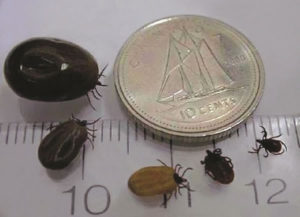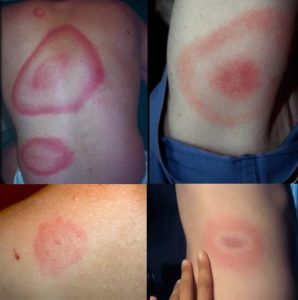Earlier this week, Canadian pop singer Avril Lavigne opened up about her experience with Lyme disease. Her emotional interview on ABC’s Good Morning America put the debilitating disease back into the spotlight, but many still don’t know what Lyme disease is.
What you Need to Know About Lyme Disease
Lyme disease is a bacterial infection transmitted through the bite of a tick carrying Borrelia burgdorferi, a spiral-shaped bacterium (spirochete). Not all ticks carry the bacterium; the most common Lyme-carrier is the Ixodes Tick – often referred to as the “black legged” or “deer” tick. Ticks pick up the illness by biting an infected animal and then pass it on to humans.

Ticks cannot jump or fly; they climb on tall grasses or shrubs and wait for a potential host to brush by them. They then transfer to the host and seek an attachment site.
Most infected people are bitten by immature (nymph) ticks; because of their small size, most people don’t notice the bite and, therefore, don’t suspect Lyme disease when they get sick. Risk of human infection is most prevalent in late spring and summer, before ticks grow into their adult size and become noticeable.

Symptoms
Lyme is difficult to diagnose because symptoms vary drastically from person to person. There are often 3 stages of Lyme infection, though they can both blur and occur quite rapidly. Lyme is most treatable during the first stage, and becomes more difficult as time passes. As Lyme progresses, it can affect every system of the body.
Lyme disease symptoms can appear quickly in some, or gradually in others. Symptoms also wax and wane, making it difficult to track as one illness. Lyme also mimics other illnesses, so it is not unlikely that those suffering the debilitating symptoms have been handed another diagnosis.
Often, infection is indicated by the onset of a distinct, “bullseye” rash (Erythma Migrans), but it is equally as likely to not experience a rash at all. The rash can be a few millimeters to very large, and circular, ovular, or triangular in shape. However, it is estimated that less than 50% of people will develop a rash.

The first physical signs of Lyme infection are often fever, sore throat, headache, congestion & stiffness, so get dismissed as the flu by many people, including doctors.
Later symptoms may include joint paint, especially in the knees. It is not uncommon for the pain to shift from one joint to another though. Lyme disease also affects the nervous system. Weeks, months, or even years after infection, sufferers may experience stiff neck & severe headache, temporary paralysis of the facial muscles, numbness, pain or weakness in the limbs, or poor coordination.
For a more complete listing of the many and varied symptoms associated with Lyme disease, visit The Canadian Lyme Disease Foundation’s website HERE.
Prevention
Lyme disease is a preventable infection. The best way to prevent infection is to avoid areas where tick infestation is probable, particularly in spring and early summer. Ticks require blood to survive, and so favour locations with dense deer populations or wooded habitats likely to be inhabited by mammals. Their ideal habitats are moist, shaded environments – especially leafy wooded areas and overgrown grassy spots.
You can decrease your chances of contracting Lyme disease by preventing tick bites with these precautions:
- Keep skin covered. When out in wooded or grassy areas, wear gloves, a hat, long sleeves and long pants tucked into socks to prevent ticks from climbing up your pants.
- Wear light coloured clothing to make it easier to spot ticks.
- Use insect repellents. While we try an avoid chemicals as much as possible, sometimes they are unavoidable. An insect repellent with a minimum of 20% of DEET works best to prevent ticks from attaching themselves to you. Apply to exposed skin and clothing, especially at openings (ankles, wrist, neck).
- Avoid low-lying brush or long grass. Walk on pathways or trails when possible, being sure to stay in the middle.
- Check for ticks often. Ticks will climb upwards until they find an area of exposed skin. Be especially vigilant after spending time in wooded or grassy areas. Some ticks are often no bigger than the head of a pin, so careful searching is necessary.
- Remove a tick as soon as possible with tweezers. Gently grasp the tick near its head or mouth. Don’t squeeze or crush the tick, but pull carefully and steadily. See your doctor or health care professional as soon as possible to rule out Lyme disease or start treatment immediately.
© Trina Waller and Western Canadian Health Products Ltd., 2014 – 2017. All rights reserved. Unauthorized use and/or duplication of this article, and the material contained within, without express written permission from this blog’s author and/or owner is strictly prohibited. Excerpts and links may be used, provided that full and clear credit is given the post author, Western Canadian Health Products Ltd., and WholeHealthatHome.com, with appropriate and specific direction to the original content.
Disclaimer: The content of this website is provided for informational purposes only. It is not intended as medical advice and should not be construed as such. Light devices are not intended to cure, treat, or prevent any disease or illness. If you have a disease or illness, consult with your physician or health care provider prior to using any light device. Use only as directed by manufacturer.
